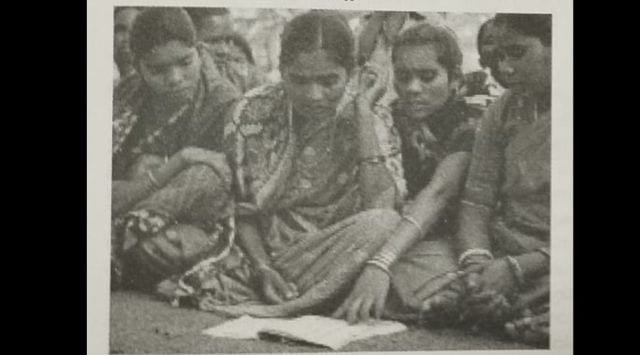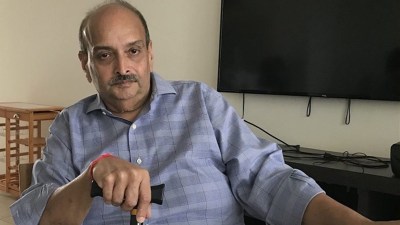How Kerala’s Kottayam achieved 100% literacy in 1989
The 100-day literacy mission in Kottayam saw hundreds of volunteers – united by the motto ‘Each One Teach One’ – join hands with officials from the municipality, district administration and MG University.
 Literacy was a "fashion statement" in the district. (Source: ‘Making a Difference’, autobiography written by Alphons Kannanthanam)
Literacy was a "fashion statement" in the district. (Source: ‘Making a Difference’, autobiography written by Alphons Kannanthanam) World Literacy Day: September 8 marks International Literacy Day and every year, the day is celebrated to remind people about the importance of literacy. For Kottayam, a district in Kerala, the day serves as a reminder of its past glory. On June 12, 1989, people in the district had created history by achieving 100 per cent literacy.
Dr C Thomas Abraham worked tirelessly to achieve this milestone. Speaking to indianexpress.com, he recalled how a survey by the National Service Scheme in 1988 in Kottayam found that there were only 2,208 illiterates in a population of 68,880, a mere 3 per cent. Abraham, the then NSS program coordinator of MG University, said he was fascinated by the data and thought about making it 100 per cent.
 A survey conducted by the National Service Scheme in Mahatma Gandhi University in 1988 found that there were only 2,208 illiterates in a population of 68,880 in Kottayam. (Credit: Abin Joseph)
A survey conducted by the National Service Scheme in Mahatma Gandhi University in 1988 found that there were only 2,208 illiterates in a population of 68,880 in Kottayam. (Credit: Abin Joseph)
The project was forwarded by then MG University vice-chancellor Dr U R Ananthamurthy and he met then municipal chairman Mani Abraham. The literacy project was sanctioned by the Ministry of Human Resources Development and Rs 63,000 was allocated. The 100-day literacy mission was carried out jointly by the municipality, district administration and MG University.
“There were 600 NSS volunteers who were graduates, who were involved in the training of 2,208 illiterates, and we worked by the motto of ‘Each One Teach One’. There were exemplary volunteers like Indulekha who had failed SSLC but she taught 17 illiterates well and won the National Youth Award,” Thomas Abraham said.

The road to changing the mindset of those reluctant to learn was not an easy one, Alphons Kannanthanam, then Kottayam district collector and former Rajya Sabha MP, explains in his autobiography ‘Making a Difference’.
Initially, those who passed Class 10 were considered eligible to be literacy mission volunteers. Later, the mandate was revoked and an eight-year-old girl turned up to teach an 80-year-old grandmother, the autobiography reveals. The volunteers used multiple ways to promote the zeal to learn. From theatre arts to aggressive media campaigns, Kottayam geared up for 100 per cent literacy.
Coordinators and mental health and social workers went door-to-door to meet and convince people. Poet Paravoor Sreedharan penned 10 poems urging the need for literacy and Mavelikara Gopinath set the tune. While coolie worker Kunjumon came forward to create a musical group in his ward, a play written by Manikandadas was staged in various other wards.
 The 100-day literacy mission was carried out jointly by the municipality, district administration and MG University. (Source: District Collectorate Kottayam website)
The 100-day literacy mission was carried out jointly by the municipality, district administration and MG University. (Source: District Collectorate Kottayam website)
“Kottayam district was the pioneer in the literacy mission. It was a people’s movement and literacy became a fashion statement in the district. Being illiterate was a sense of shame for people. Literate does not simply mean the ability to read and write, but the ability to use the language and do calculations,” Kannanthanam told indianexpress.com over the phone.
With literacy becoming a “fashion statement”, many were hesitant to publicly reveal they were illiterate. Volunteers taught such people at home and this helped them attend to the specific needs of each student.
Thomas Abraham shared a moving anecdote. Joby Zyriac, an NSS volunteer, was left emotional after he visited Gadijaumma’s house. “She welcomed him to the small house and asked him how she would learn. Her son was mentally retarded and she was taking care of him,” he said. Heartbroken by her plight, Zyriac left the place, only to return after two days. How will the mission be complete if I did not learn, Gadijaumma asked Zyriac.
 Kottayam’s public library was established in 1982 to promote reading habits among people (Credit: Abin Joseph)
Kottayam’s public library was established in 1982 to promote reading habits among people (Credit: Abin Joseph)
In another heart-touching incident, Kuttapan, a man belonging to the Scheduled Tribe community, was firm on his decision not to learn. Recollecting how they changed his mindset, Abraham says Kuttapan’s decision was rooted in his experiences. “At the age of seven, he had joined school but only attended classes for eight days. He fought with his friend and the headmaster gave him 12 blows while his upper caste friend was spared punishment. When the headmaster tried to remove the only towel he wore in front of the whole class, he threw his slate on the teacher’s face and fled the world of letters. He escaped to his neighbour’s house for a week and after being found, he was tied to a tree by his father and beaten up. The child made a promise in a temple – never to learn,” he said.
As volunteers persuaded Kuttapan to learn, he threatened to file a case against them and attempt suicide. Kuttapan was taken to Kannanthanam’s residence and offered meals, including rice, chicken and fish curry. Kannanthanam’s words moved Kuttapan and his wife Kochpenn also persuaded him. Kannanthanam told him that they were in ‘Devalokam’, which literally means ‘land of god’, and it was okay to break his promise to god here. The then collector held his hand forward and within 30 seconds, Kuttapan made his promise. He also gave Re 1 as an offering to Kannanthanam, Abraham recalled.
 CMS press was the first printing press in Kerala (Credit: Abin Joseph)
CMS press was the first printing press in Kerala (Credit: Abin Joseph)
Malappuram native K V Rabiya also played a major role in the adult literacy campaign in the state. The Padma Shri awardee had set up a library for women, Aksharakootayma Charitable Society, and taught scores of illiterates. Speaking to indianexpress.com over the phone, she said she was a voracious reader since childhood and books were her friends. Paralysed at an early age, she said it never dampened her spirit. She led the campaign sitting in a wheelchair and spent more than 20 years as a teacher.
Recollecting the days she taught for the literacy mission, she said that her class was chosen as the best class when officials carried out an inspection. “I taught my students to write well by making the alphabet round and clear. All of them wrote in a similar way. I used to give them zero marks when they made errors,” she recalled.
 The Rev. Benjamin Bailey from Yorkshire, England arrived in Kerala at the age of 25 as a member of Church Missionary Society. He founded the CMS press in Kottayam, the first press in the state. (Credit: Abin Joseph)
The Rev. Benjamin Bailey from Yorkshire, England arrived in Kerala at the age of 25 as a member of Church Missionary Society. He founded the CMS press in Kottayam, the first press in the state. (Credit: Abin Joseph)
Kottayam is also home to Kerala’s first printing press established by Englishman Rev Benjamin Bailey in 1821. Abraham Itticherian, president of the Kottayam Public Library, says, “It was not very difficult to promote literacy in Kottayam. There were a lot of well-educated people in the district. CMS College was established in 1910 and the public library was set up in 1982, which was one of the earliest efforts made to promote a reading habit among people.”
 CMS College, the first Western style college in India was established in 1910 (Credit: Abin Joseph)
CMS College, the first Western style college in India was established in 1910 (Credit: Abin Joseph)
The administration continues to strive to elevate literacy levels in the district. “As there are no coastal or tribal pockets in the district, illiterate pockets are not found here and identification is not easy…During our mission 2020, our target was to make those less than 50 years of age pass the 10th standard. In 2021, it was to make them clear higher secondary level examinations,” said Dr V V Mathew, district coordinator of Literacy Mission. “Equivalency programmes are now going on for the Class 4 level exam. On September 10, 507 people will take the 10th-level exam. Digital literacy programmes are also going on,” he added.



- 01
- 02
- 03
- 04
- 05




























